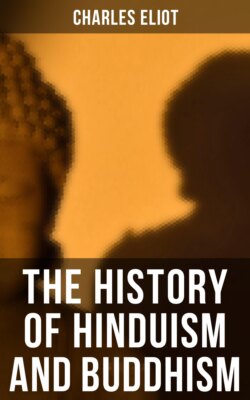Читать книгу The History of Hinduism and Buddhism - Charles Eliot - Страница 55
На сайте Литреса книга снята с продажи.
2
ОглавлениеAccording to the Jain scriptures all Jinas are born in the warrior caste, never among Brahmans. The first called Rishabha, who was born an almost inexpressibly[263] long time ago and lived 8,400,000 years, was the son of a king of Ayodhyâ. But as ages elapsed, the lives of his successors and the intervals which separated them became shorter. Parśva, the twenty-third Jina, must have some historical basis[264]. We are told that he lived 250 years before Mahâvîra, that his followers still existed in the time of the latter: that he permitted the use of clothes and taught that four and not five vows were necessary[265]. Both Jain and Buddhist scriptures support the idea that Mahâvîra was a reviver and reformer rather than an originator. The former do not emphasize the novelty of his revelation and the latter treat Jainism as a well-known form of error without indicating that it was either new or attributable to one individual.
Mahâvîra, or the great hero, is the common designation of the twenty-fourth Jina but his personal name was Vardhamâna. He was a contemporary of the Buddha but somewhat older and belonged to a Kshatriya clan, variously called Jñâta, Ñâta, or Ñâya. His parents lived in a suburb of Vaiśâlî and were followers of Parśva. When he was in his thirty-first year they decided to die by voluntary starvation and after their death he renounced the world and started to wander naked in western Bengal, enduring some persecution as well as self-inflicted penances. After thirteen years of this life, he believed that he had attained enlightenment and appeared as the Jina, the head of a religious order called Nirgaṇṭhas (or Nigaṇṭhas). This word, which means unfettered or free from bonds, is the name by which the Jains are generally known in Buddhist literature and it occurs in their own scriptures, though it gradually fell out of use. Possibly it was the designation of an order claiming to have been founded by Parśva and accepted by Mahâvîra.
The meagre accounts of his life relate that he continued to travel for nearly thirty years and had eleven principal disciples. He apparently influenced much the same region as the Buddha and came in contact with the same personalities, such as kings Bimbisâra and Ajâtasattu. He had relations with Makkhali Gosâla and his disciples disputed with the Buddhists[266] but it does not appear that he himself ever met Gotama. He died at the age of seventy-two at Pâvâ near Râjagaha. Only one of his principal disciples, Sudharman, survived him and a schism broke out immediately after his death. There had already been one in the fifteenth year of his teaching brought about by his son-in-law.
